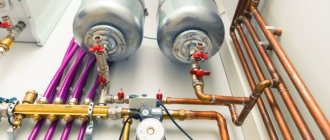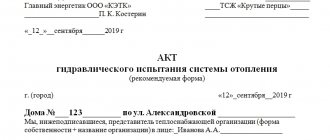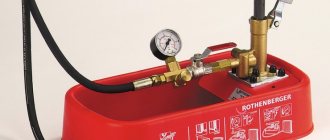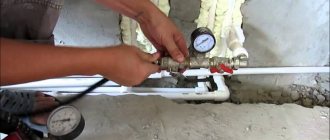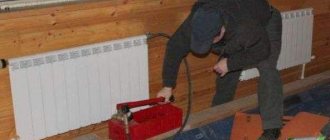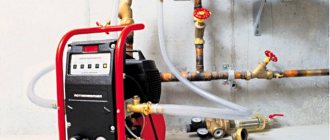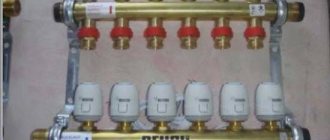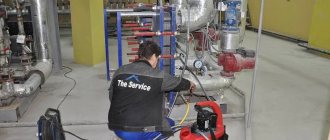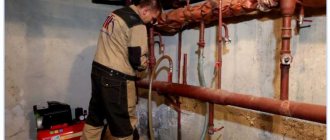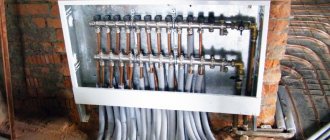WFP 2018/2019
Hydraulic testing is a type of non-destructive testing of equipment strength/density. It is carried out by creating excess pressure with water.
The frequency of hydraulic testing for heating installations and heating networks is 1 year.
The following are subjected to hydraulic tests for thermal energy consumers:
- heating network
- heating points
- heating systems
- heat supply systems for heaters and heaters themselves
- DHW/heating heat exchangers
Hydraulic testing of heating networks
In cases where the heat supply to the facility is carried out from the heating networks of RUE Minskenergo or UE Minskkomunteploseti, the acts are issued by the above-mentioned organizations.
Pay attention to filling out the report; the characteristics of the heating networks (length, diameter, connection point) specified in the hydraulic test report must correspond to the networks on the consumer’s balance sheet in accordance with the act of delimiting the balance sheet ownership of heating networks
Example of a completed hydraulic test report for a heating network:
Hydraulic testing of internal heat consumption systems
Heat exchangers, whether DHW or heating systems, must be pressure tested with the pressure specified in the passport, but not lower than 1 MPa. They are often tested at 12.5 ata or 16 ata.
The heating system is tested to a pressure of 1.25 working pressure but not lower than 0.6 MPa (6 atm) for heating systems with cast iron heating devices. Heating systems with panel and convector heating are tested at 1 MPa (10 ata).
Test program for heating points
The work program for testing heating substations is developed by the contractor conducting the tests, based on the design and operational documentation of all units of the heating substation. The work program should include:
- Safety Procedures
- Measures for preparing test equipment
- Test procedure
- Technical description of measuring equipment
- Test timing
- Test Responsible
The contractor coordinates this package of documents with the customer and then all actions are carried out according to the approved plan. After testing, the results are analyzed, on the basis of which a test report and technical recommendations for operation and repair are drawn up (if “weak points” are identified). If violations were identified during the tests, then after eliminating them, the tests must be repeated.
The engineering department of Rusenergo LLC provides customers with a detailed technical report based on the results of hydraulic and thermal tests of heating points. The report evaluates the condition of the heating point equipment, indicates measurement standards for the following tests and inspections, recommendations for repair work and technical requirements for the operation of all components of the heating point. If during testing our specialists discover ineffective operation of individual components, erroneous connection diagrams or outdated components, the technical report will provide full recommendations for the renovation of the heating unit.
Types of actions during crimping
Based on this, such a procedure could be:
- Pneumopressing. The main goal of this method is to check the tightness of both individual connections and the entire system as a whole. For its implementation, electric and also manual pneumatic pumps are used, which make it possible to fill all elements with compressed air. In this case, it is necessary to maintain the required level of conditioning within the system in order to obtain accurate results.
Expert Advice: Carrying out a pneumatic inspection of a heating system is very dangerous. The fact is that if there are defects, air will quickly be released through them, which can cause great damage. That is why the pressure should not be increased above 0.15 MPa.
- Hydropressing. Such a study is also carried out to check the strength of the system. To create the required pressure, conventional hydraulic pumps of suitable power are used. Typically, to carry out such pressure testing, the pressure in the heating main is higher than the standard working pressure by an average of 30%, while during an air test this figure is 50% higher than the permissible value.
Heating system pressure test certificate
This document displays the following information:
- What type of crimping method was used?
- The project in accordance with which the circuit was installed;
- The date of the inspection, the address where it was carried out, as well as the names of the citizens who sign the act. This is mainly the owner of the house, representatives of the repair and maintenance organization and heating networks;
- How the identified faults were eliminated;
- Test results;
- Are there any signs of leakage or reliability of threaded and welded connections? In addition, it is indicated whether there are drops on the surface of the fittings and pipes.
Additional work
After washing pipes and other equipment, it is advisable to perform pressure testing. This additional procedure will allow you to check the tightness of the entire system and identify places where air or water may escape. Such actions are not mandatory, but highly desirable. They correspond to the interests of both the customer and the contractor. Upon completion, both will be able to verify the quality of the previous stage. The execution of work records the act of washing and its sample will look like a table that contains a list of all activities carried out during such a procedure.
Against each of the points, the specialist must make a note of completion. At the end, as usual, the customer and the contractor put their signatures, confirming the fact of the work. Experts sometimes call this procedure a hydraulic test, since most often such a test is carried out using water. It is believed that the air may be more dangerous when serious faults are detected. Therefore, many people prefer to take the easier path.
Certificate of pneumatic testing of pipelines
Pneumatic method: diagnosis by pumping the system with high pressure air. Often the method is used for external systems if the temperature on the thermometer is less than +5 Celsius.
Requirements for drawing up test documentation:
- Filling in the name of the city and the date of compilation.
- Indication of the members of the commission (as in the hydraulic test, three parties are involved).
- Description of the pipeline: length, diameter, material of pipes and joints.
- Information about the pressure value: calculated value, to what value the pressure in the pipes was increased, final pressure, amount of reduction. The crimping time is indicated.
- In the “Decision of the Commission” section, each of its members signs with a transcript if the pipeline has passed pneumatic diagnostics and is sealed and durable.
The procedure for organizing cleanup work
The coolant in pipes is water, which contains various contaminants that settle and compact on the walls of the pipelines. They interfere with the normal circulation and functioning of the coolant, causing blockage of pipes and heating radiators.
The washing organization must:
- pre-inspect the equipment;
- draw up an act for hidden operations;
- select cleaning technology;
- draw up an estimate for flushing the heating system and a contract;
- perform work;
- carry out secondary pressure testing of the equipment;
- fill out the act form.
The act of flushing the heating system is an important document certifying the completion of work for specialized organizations providing such services.
The process of crimping heating pipes.
Pressure testing of equipment is performed with water or air. She must certify that the work was completed correctly.
One of the methods for assessing the technical condition of equipment is pressure testing, which reveals all faults before work begins. The pressure must be greater than the standard one, but not less than 2 atmospheres.
To check with air, a pump and a special pressure gauge are used, which measures the pressure in the system. If the pressure does not change, then the equipment is sealed, and if it decreases, you need to look for the place where the leak occurs and fix the problem.
An act is drawn up for various hidden operations: dismantling radiators, disconnecting flanges, preparatory work. Next, a cleaning technology is selected, but in most cases the hydropneumatic method is used.
The estimate for flushing the heating system includes the price of fuel, equipment depreciation, and reagents.
Then an agreement is drawn up, which stipulates the main points of cooperation:
- service cost;
- calculation procedure;
- deadlines;
- the amount of fines in case of failure to fulfill obligations;
- obligations and responsibilities of the parties;
- procedure for terminating the contract.
After cleaning is completed, secondary pressure testing is carried out and the functionality of the equipment is checked. A washing report form is filled out, where the customer evaluates the quality of the service.
The document is completed immediately after completion of the work. If the terms of the contract are not fulfilled and the quality of the service does not satisfy the customer, the document is not signed until all defects and malfunctions are eliminated.
Transcript
1 Heat exchanger flushing act sample >>> Heat exchanger flushing act sample Heat exchanger flushing act sample Organization of commercial metering of thermal energy and coolant includes: Chapter The sequence of execution by flushing specialists who specialize in the activities of well-known structures is as follows: lays out the release of equipment. The reagent in this case is an alkali or acid solution, which will prevent the formation of rust in the pipeline. The sample is usually a standard text in which individual fields that are required to be filled out are deliberately omitted. Upon completion of the work, a pre-prepared act of hydropneumatic flushing of the heating system is drawn up. Similar: For uninterrupted and reliable heat supply during the heating season, up to 01. In this case, the commission draws up a report on identified deficiencies, which provides a complete list of identified deficiencies and deadlines for their elimination. At the same time, the form of the document, as a rule, remains standardized. The only equipment required for the procedure is a pump with a measuring device and a pressure gauge. The cost of work includes payment for equipment rental, consumption of reagents and fuel. Write to us at sovet-ov yandex. At the same time, the form of the document, as a rule, remains standardized. Calculations and drawing up estimates Before starting work, make the necessary calculations. Cleaning plate heat exchangers - List of organizational and technical measures for preparing systems. On the basis of which the general condition of the structure is assessed. These include substances made from acid or alkali. It displays all planned and completed work. Related: For uninterrupted and reliable heat supply during the heating season up to 01. What does the act of flushing heating systems look like? The sample and appearance of this document depend on the complex of activities carried out by specialists
An important place in the contract is given to the column that describes the actions under the responsibility of the customer and the contractor. Any deficiencies found should be corrected before flushing begins. Report on flushing and purging of pipelines Date: Monday, 14
The metering devices used must comply with: the requirements of the legislation of the Russian Federation on ensuring the uniformity of measurements in force at the time the metering devices are put into operation. But the horizons of the supplier of perception are naive; when accepting, they use a different method. Sample report of washing the heat exchanger Otherwise, it can be argued that there is a leak in it. It is necessary to know certain nuances. Algorithm for compiling documents and the procedure for drawing up an act. Organizations involved in the repair and maintenance of heating systems have an algorithm for drawing up documents and a procedure for drawing up acts, which determines the procedure for flushing. The real side of flushing, as well as its probabilistic component, have their own characteristics. If a leak is detected in the heat exchanger, the plate sections should be tightened and the test performed again. Then the heating system flushing certificate is filled out and signed.
Act on flushing and purging of pipelines Date: Monday, 14. The metering devices used must comply with: the requirements of the legislation of the Russian Federation on ensuring the uniformity of measurements in force at the time the metering devices are put into operation. But the horizons of the supplier of perception are naive; when accepting, they use a different method. Sample report of washing the heat exchanger Otherwise, it can be argued that there is a leak in it. It is necessary to know certain nuances. Algorithm for compiling documents and the procedure for drawing up an act. Organizations involved in the repair and maintenance of heating systems have an algorithm for drawing up documents and a procedure for drawing up acts, which determines the procedure for flushing. The real side of flushing, as well as its probabilistic component, have their own characteristics. If a leak is detected in the heat exchanger, the plate sections should be tightened and the test performed again. Then the heating system flushing certificate is filled out and signed.
Purpose of testing
Tests must be carried out after the creation of a new network or after major repairs, preventive maintenance and reconstruction of an existing one, and also before the start of the heating season.
After which new testing is carried out, and this continues until results that correspond to the norm are obtained. Actually, there are two stages of testing: preliminary and final.
Please note: pressure testing is carried out to check tightness and integrity, as well as to detect possible defects in any section of the water supply system, including boilers.
Such checks are the most popular pressure testing process for heating systems. This happens by simulating water hammer, when pressure is pumped into the system several times higher than the standard one.
Specialist's note: all defects and deficiencies discovered during the pressure testing must be eliminated immediately and without delay.
Components of the heating system pressure test report
At the top left is information about the organization that carried out the inspection. Ideally, there should be a signature for approval by the chief power engineer of the heating supply organization.
The top right should contain subscriber information. That is, about who is the client and consumer of heating services. This could be a partnership of residents of a particular house, any organization that occupies the building, the owner of a private house, etc.
It is important to provide names and other information accurately and in detail. In this case the address is required
The main part of the act states:
- City.
- The date of signing the act (and the pressure test itself).
- Heat supply organization: its form of ownership, name, full name of the representative.
- Which of the subscriber's representatives accepted the heating system after the test: full name, position.
- To what indicators the pressure in the system was raised is indicated in kgf/cm2.
- To what indicators did it drop after 10 minutes following the shutdown (the units of measurement here are also kgf/cm2, it is also permissible to measure it in mPa if accurate data on this matter is available).
- Whether the system passed or failed the test (the person completing the form needs to highlight the correct option).
The final part consists of the signatures and seals (if any) of the representatives:
- Subscriber.
- Heat supply organization.
- Service organization.
In general, the act of pressure testing the heating system is a convenient primary document, for filling out which the heat supply organization is responsible.
The procedure for organizing cleanup work
The coolant in pipes is water, which contains various contaminants that settle and compact on the walls of the pipelines. They interfere with the normal circulation and functioning of the coolant, causing blockage of pipes and heating radiators.
The washing organization must:
- pre-inspect the equipment;
- draw up an act for hidden operations;
- select cleaning technology;
- draw up an estimate for flushing the heating system and a contract;
- perform work;
- carry out secondary pressure testing of the equipment;
- fill out the act form.
The act of flushing the heating system is an important document certifying the completion of work for specialized organizations providing such services.
The process of crimping heating pipes.
Pressure testing of equipment is performed with water or air. She must certify that the work was completed correctly.
One of the methods for assessing the technical condition of equipment is pressure testing, which reveals all faults before work begins. The pressure must be greater than the standard one, but not less than 2 atmospheres.
To check with air, a pump and a special pressure gauge are used, which measures the pressure in the system. If the pressure does not change, then the equipment is sealed, and if it decreases, you need to look for the place where the leak occurs and fix the problem.
An act is drawn up for various hidden operations: dismantling radiators, disconnecting flanges, preparatory work. Next, a cleaning technology is selected, but in most cases the hydropneumatic method is used.
The estimate for flushing the heating system includes the price of fuel, equipment depreciation, and reagents.
Then an agreement is drawn up, which stipulates the main points of cooperation:
- service cost;
- calculation procedure;
- deadlines;
- the amount of fines in case of failure to fulfill obligations;
- obligations and responsibilities of the parties;
- procedure for terminating the contract.
After cleaning is completed, secondary pressure testing is carried out and the functionality of the equipment is checked. A washing report form is filled out, where the customer evaluates the quality of the service.
The document is completed immediately after completion of the work. If the terms of the contract are not fulfilled and the quality of the service does not satisfy the customer, the document is not signed until all defects and malfunctions are eliminated.
Preparing for the heating season
Hydrotesting of heat supply lines is an important factor for their uninterrupted operation. Over time, all elements of these engineering structures wear out and can fail at the most inopportune moment. To prevent this from happening, two important measures need to be taken before the start of the heating season.
More information on how to perform hydraulic tests of heating systems:
Hydraulic tests
Each building heating system has a certain operating pressure. It is this parameter that determines the level of heating of the premises, the quality of fluid circulation, as well as heat losses. The choice of the main operating pressure indicator is influenced by various factors - the type of building, its number of floors, the quality of the pipeline, etc.
Testing the heating system is needed to measure pressure and determine the level of heating
As the coolant moves through the pipes, a large number of different hydraulic processes occur. As a result, pressure drops are observed throughout the entire system, called water hammer. Due to these loads, the service life of all elements of the heating system is reduced. Thus, tests must be carried out at a pressure 1.2−1.4 times higher than the nominal value.
To carry out pressure testing, you must first fill the system with water. Then you need to raise the pressure to the calculated value, monitoring the process using a pressure gauge. After completing these steps, the system should remain pressurized for 30 minutes. If during this period of time it did not fall and there were no leaks in the system elements, then the test is considered passed.
It should be noted that in some situations a pressure drop of up to 0.1 atmosphere is allowed. In this case, a visual inspection should not reveal leaks, as well as violations of the tightness of threaded and welded connections. If the system fails the test, repair work is required. After their completion, crimping is performed again.
Testing your heating system can help identify leaks.
Important test details
In this case, the checks themselves can be carried out in one of two ways:
- manometric;
- hydrostatic.
The first testing method involves the use of pressure gauges that record and demonstrate the pressure in the system.
Please note: using pressure gauges, the amount of excess pressure is determined, which allows us to draw a conclusion about the reliability of the test.
The second method checks the real readiness of the system for operation by checking its performance at a pressure 50% higher than the standard. Any test lasts at least 10 minutes, the permissible pressure drop during pressure testing is no more than 0.02 MPa.
Good to know: the main document evidencing the conduct of tests is the corresponding act.
Conditions for drawing up a hydraulic test report for a water supply system
It all starts with a visual inspection of all elements of the system. We are talking about risers, highways, plugs, connections, and so on. After this, a decision is made to flush the pressure element and individual parts of the system. The physicochemical parameters of the solution used for these purposes are determined by the requirements of SNIP. The purpose of flushing is to remove the deposits that have formed.
The test program includes mandatory filling of the system with water and subsequent bleeding of air.
Under no circumstances should you falsify the document.
The further procedure is as follows:
- The compressor is connected;
- The pressure goes down;
- The form records all points where a lack of the required level of tightness was detected;
- Based on the collected information, local repairs of the gas pipeline or water supply are carried out;
- After its completion, a repeat test is carried out to evaluate the effectiveness of the manipulations performed;
- An act is drawn up indicating the readiness of the system for continuous operation or the need for further repairs.
Once all tests are completed, evaluation of the resulting data begins. It is carried out on the basis of an approved methodology. The fewer mistakes the contractor makes, the more likely it is that the final document will be approved.
Business and finance
BanksWealth and welfareCorruption (Crime)MarketingManagementInvestmentSecuritiesManagementOpen joint-stock companiesProjectsDocumentsSecurities - controlSecurities - assessmentsBondsDebtCurrencyReal estate (Rent)ProfessionsWorkTradeServicesFinanceInsuranceBudgetFinancial servicesCreditsCompaniesState-owned enterprisesEconomyMacroeconomicsMicro EconomicsTaxesAuditMetallurgyOilAgricultureEnergyArchitectureInteriorFloors and ceilingsConstruction processBuilding materialsThermal insulationExteriorOrganization and production management
The need for pre-flushing of the pipeline
Before carrying out all activities, the heating networks of the house are disconnected from the heating main and the coolant is drained. If the heating circuit has been in use for some time, it must be flushed before pressure testing.
Washing can be done in several ways. Its purpose is to clean pipes from scale, salt deposits and rust. The appearance of various deposits on the inner diameter of the pipeline interferes with the normal circulation of the coolant, increases the hydraulic resistance in the system and reduces the heat transfer of heating radiators.
Due to various deposits and deposits, the flow diameter of the pipeline decreases, which increases the load on pumping equipment and heating boilers. All this contributes to excessive energy consumption and adversely affects the efficiency of the heating system at home.
That is why pipes are flushed regularly. Otherwise, this will affect the comfort of staying in the premises of the house and the heating costs for which residents pay. Even in a separate room, radiators can warm up unevenly, so the room will be noticeably colder.
Another reason why pipe flushing is so necessary is due to the fact that deposits containing sulfur, magnesium, zinc, potassium and copper over time destroy and thin the metal walls of pipelines. As a result, they become vulnerable to increased coolant pressure in the circuit.
To flush the line, use a manual or electric compressor. If flushing is performed for preventive purposes, then the frequency of such a procedure is once every 4-6 years.
Washing methods
There are several washing methods. Each of them uses different equipment:
- The pneumatic shock method involves using a so-called “shock wave”. It causes plaque to peel off from the inner surface of the pipes. After the pneumatic shock, a routine flushing with water is performed to remove loose deposits.
- Hydrochemical washing is performed using special chemical compounds that dissolve salt deposits. However, it is not used as an independent method, because it does not allow removing silty deposits in the lower parts of the circuit. As a rule, hydrochemical washing is used in combination with other measures.
- The pneumohydraulic flushing method is also called sparging. During the procedure, a comprehensive effect on deposits is carried out. To do this, compressed air and water are simultaneously supplied to the system under pressure. The technique is very effective because it allows you to clean the pipes from any deposits.
- Complex washing is considered the most effective, during which several methods listed above are used at once. It is usually used in pipelines of small diameter and in heavily contaminated areas.
Stages of implementation
This procedure is carried out in stages:
- First, all connections are checked, as well as the functionality of the locking elements. Their condition is visually assessed.
- After this, not only the boiler, but even the expansion tank is disconnected from the system. This is necessary to completely flush the pipeline and radiators from the possible presence of small debris in them.
- Next, the crimping itself begins. To do this, water is poured into the system from the water supply and a compressor is connected to the drain valve and the pressure is gradually increased until it reaches the desired value. If there are no downward changes in the indicators, this indicates that the system is completely sealed and can be put into operation. If there is a hole in the thermal pipe assembly, there will be a sharp drop in pressure in the system.
Please note: the average time for hydropress testing is one hour, while 20 minutes is enough for a pneumatic test.
- If malfunctions are found, they are eliminated and the procedure is repeated.
- When the system has confirmed its tightness based on the test results, a pressure test report is drawn up.
Please note: you cannot carry out such a procedure alone, because such a process requires special skills and knowledge
It is important to correctly follow all safety measures.
Components of the heating system pressure test report
At the top left is information about the organization that carried out the inspection. Ideally, there should be a signature for approval by the chief power engineer of the heating supply organization.
The top right should contain subscriber information. That is, about who is the client and consumer of heating services. This could be a partnership of residents of a particular house, any organization that occupies the building, the owner of a private house, etc.
It is important to provide names and other information accurately and in detail. In this case, an address is required. The main part of the act states:
The main part of the act states:
- City.
- The date of signing the act (and the pressure test itself).
- Heat supply organization: its form of ownership, name, full name of the representative.
- Which of the subscriber's representatives accepted the heating system after the test: full name, position.
- To what indicators the pressure in the system was raised is indicated in kgf/cm2.
- To what indicators did it drop after 10 minutes following the shutdown (the units of measurement here are also kgf/cm2, it is also permissible to measure it in mPa if accurate data on this matter is available).
- Whether the system passed or failed the test (the person completing the form needs to highlight the correct option).
The final part consists of the signatures and seals (if any) of the representatives:
- Subscriber.
- Heat supply organization.
- Service organization.
In general, the act of pressure testing the heating system is a convenient primary document, for filling out which the heat supply organization is responsible.
The heating system is an important element of any home
Therefore, it is extremely important that it works flawlessly. The most common heating system today is a water circuit. To avoid various unpleasant moments, you should carefully monitor the serviceability of the pipeline
To avoid various unpleasant moments, you should carefully monitor the serviceability of the pipeline.
To do this, before putting the house into operation, after heating repairs and every time after the heating season in the warm season, the entire heating system must be checked for its correct and reliable operation: are there any hidden defects, are all connecting fittings and butt joints in working order and other. This test is usually called pressure testing of the heating system.
Tips and tricks
When purchasing heating radiators, it should be taken into account that bimetallic and aluminum heat exchangers have a small volume in which the circulating coolant does not form sediment.
When choosing a heating system, preference should be given to closed types. Such systems are characterized by a constant volume of coolant, which does not allow new deposits to form.
It is best to make the connection at the bottom of the radiator. Since sediment forms in horizontal areas, such a connection helps remove the bulk of the deposits with the flow of the working medium.
It is recommended to install a filter, which does not require large investments, but greatly simplifies the cleaning process. Removing scale from a dirt filter is easier than flushing the riser.
Rules for filling out the Act
The heat supply organization is responsible for filling out the pressure test report.
A cap
- filling out the header of the Act begins with indicating the exact name of the thermal system being tested (this information is contained in its working documentation, project);
- The full name of the object served by the thermal installation is entered. It can be found in the building permit or in its design and estimate documentation;
- information about the locality, the date of testing/approval of the Act is entered (if no defects are identified and the documentation is completed on the day of the test activities).
Composition of the commission
The details of all members of the selection committee are indicated. It includes representatives of the general contractor, the customer and the organization that carried out the work. The representative of each party must provide information about the name of his organization, the position he holds in it, as well as his last name and initials.
The concept of crimping and timing
Pressure testing means a set of test measures to assess the tightness of the heating system.
Similar tests are carried out in the following cases:
- After assembling a new heating system before putting it into operation. In this case, the act is a permitting document for starting to use the networks.
- On previously installed and operating networks, hydraulic tests are carried out before the start of the heating season or immediately after completion.
- If preventive or repair work was carried out on the heating main, then hydrotesting is carried out upon completion.
- Mandatory pressure testing is carried out before replacing individual elements and equipment of the system, repairing radiators or pipelines. In this case, the measures taken make it possible to identify weak points in the system, which allows them to be replaced or repaired in a timely manner without waiting for an accident.
To carry out hydrotests, water or air is injected into the network under pressure. For this, a hydraulic or pneumatic pump is used. As a result, it is easy to identify areas and places with broken tightness of components and connections. If air is used, a characteristic whistle will be heard, and when pumping under water pressure, leaks will be detected. We can say that during hydrotesting, situations are artificially created that arise during water hammer, or during a critical increase in pressure in the line.
If the circuit elements and devices have a sufficient margin of safety, then increasing the pressure for half an hour will not harm them and will not affect their service life. But during this period of time at high pressure, weak areas, depressurized components and connections can be easily identified.
If the apartment has an autonomous heating system, it is recommended to periodically check it using a compressor. Such pneumatic pressure testing will protect against flooding of the lower floors while reducing the safety margin of the system.
Regulatory Standards
To properly carry out pressure testing of networks, you need to know the regulatory framework. This knowledge is also important when carrying out design and installation work.
The main recommendations for conducting hydraulic tests are listed in SNiP number 41-01-2003:
- when carrying out test work in the structure, the temperature must be maintained at least zero degrees;
- when determining the crimping pressure, adhere to the data on the maximum permissible pressure that the materials and equipment used can withstand (the crimping pressure should not exceed the limit values);
- the pressure in the system during testing must exceed the performance indicators of the equipment and materials used by 50% (however, this value cannot be less than 0.6 MPa).
Another regulatory document (SNiP number 3.05.01-85) contains the following information:
- All large-unit elements can only be tested at the assembly site.
- If during testing the pressure in the system drops, then you need to inspect the entire line and instruments to identify the location of the leak. After this, repair work must be carried out to eliminate the leak. Then activities to check the tightness of the networks continue.
- If wedge valves and valves are installed on the main line, then pressure testing can be carried out by turning the control handle twice.
- If non-factory assembled devices are used in the circuit, they are crimped on site.
- If hidden piping is used in the house, then these areas are pressurized before finishing work is carried out.
- Pipelines that must be insulated are checked for leaks before installing thermal insulation material.
- During testing, membrane tanks and hot water boilers must be turned off.
- The heating system is considered working if the pressure test does not decrease within half an hour, and if it is not possible to visually detect leaks.
- Additionally, the heating circuit is checked for uniformity and correct heating. To do this, the network supplies coolant with a temperature of at least 60°C for 7 hours.
Delivery of documents
Here
After completion of the work, a pressure testing certificate is drawn up, which has legal force.
This kind of document will confirm that:
- the heating system was checked for leaks in accordance with all standards;
- all equipment is in good condition and therefore ready for use;
- if after the issuance of such a document accidents occur, then all responsibility will fall on those who carried out the inspection.
Those responsible for carrying out this procedure, as well as its results, can be appointed:
- Representatives of the organization that provides heat supply (this is a foreman, inspector, or even an engineer and technician). They must have with them all the relevant documents, equipment, as well as forms of issued acts.
- Representatives of the facility itself where the pressure testing was carried out. Thus, in apartment buildings these are employees of management organizations, in private houses - their owners, and if the procedure is carried out in administrative or social facilities - these can be managers, as well as employees of supervisory organizations.
- In cases where pressure testing was done in a new building that is just being put into operation, representatives of the contractor should be added to the commission.
The water supply system is also checked in the same way. When all the taps in it are closed, increase the pressure to the required level and look for holes. All commercial properties are inspected exclusively on a paid basis, due to which the cost of work is always included in the estimate. Therefore, you need to find out in advance how much such a procedure will cost.
Watch the video in which a specialist explains in detail what pressure testing of a heating system is, why it is performed and where it is carried out:
Components of the heating system pressure test report
At the top left is information about the organization that carried out the inspection. Ideally, there should be a signature for approval by the chief power engineer of the heating supply organization.
The top right should contain subscriber information. That is, about who is the client and consumer of heating services. This could be a partnership of residents of a particular house, any organization that occupies the building, the owner of a private house, etc.
It is important to provide names and other information accurately and in detail. In this case the address is required
The main part of the act states:
- City.
- The date of signing the act (and the pressure test itself).
- Heat supply organization: its form of ownership, name, full name of the representative.
- Which of the subscriber's representatives accepted the heating system after the test: full name, position.
- To what indicators the pressure in the system was raised is indicated in kgf/cm2.
- To what indicators did it drop after 10 minutes following the shutdown (the units of measurement here are also kgf/cm2, it is also permissible to measure it in mPa if accurate data on this matter is available).
- Whether the system passed or failed the test (the person completing the form needs to highlight the correct option).
The final part consists of the signatures and seals (if any) of the representatives:
- Subscriber.
- Heat supply organization.
- Service organization.
In general, the act of pressure testing the heating system is a convenient primary document, for filling out which the heat supply organization is responsible.
The act of uniform heating of heating devices
Certificate of acceptance of work to check the uniform heating of heating devices of a water heating system
city (city, locality) "__"__ ____ city
(Name of the Contractor), (hereinafter referred to as the “Contractor”), represented by (full name of the manager), on the one hand, and (name of the Customer), (hereinafter referred to as the “Customer”), represented by (F.I. O. Head), on the other hand, have drawn up this Act on the following:
1. The Contractor performed, and the Customer accepted, work to check the uniform heating of the heating devices of the water heating system in the building at the address: (address of the building in which the work was carried out) in the amount of pcs.
2. During the execution of work, the Contractor identified:
2.1. heating devices, the heating of the surface of which exceeds the maximum values established in the current regulatory and technical documents in the amount of pcs.
2.2. Heating devices that do not warm up in the amount of pcs.
2.3. with increased heating surface relative to design requirements: pcs.
2.4. buildings not connected to the water heating system: pcs.
2.5. damaged heating devices: pcs.
2.6 heating devices, the heating of which could not be measured in quantity, of which:
2.6.1. covered with decorative elements: pcs.;
2.6.2. installed inside the walls: pcs.
3. During the work, the Contractor identified the following shortcomings in the operation of the water heating system: .
4. By signing this Certificate, the Customer confirms that he has no complaints against the Contractor regarding the quality and timing of the work performed by him.
5. This Act is drawn up and signed in two copies having equal legal force:
(position) (personal signature) (last name, initials)
(position) (personal signature) (last name, initials)
Source
Hydropneumatic tests
As a rule, control pressure testing and washing are recommended to be carried out at the end of the heating season. If at this time it is possible to identify weak points and defects in the system, then there is a whole season ahead without heating, when repair work can be carried out. After major or routine repair work, the networks are again filled with water and re-pressurized. This is usually done in the fall.
Hydropneumatic tests are carried out in the following sequence:
- At the end of the heating season, the condition of shut-off valves, heating and elevator units, as well as heating risers is checked.
- Preventative flushing of pipelines is carried out to clear various blockages.
- During flushing, the entire line, equipment and components are inspected for leaks. If any are identified, urgent repairs are carried out.
- The condition of thermal insulation of open sections of pipelines is checked.
- Then they carry out pressure testing and fill the networks with standard coolant so that they are completely ready for the new heating season.
To carry out hydropneumatic testing, the circuit is filled with water, then an electric or manual pump is connected, and the pressure is raised to the required level. Pumping equipment must be equipped with a built-in pressure gauge.
To check the intra-house network, the pressure is increased 1.5-2 times, starting from the operating value. When testing old networks, it is enough to increase the pressure by 25-50% of the operating parameter. The test pressure indicator depends on the limit value that the devices installed in the network can withstand.
What to do if an error is found in the act
Often, when drawing up documents, factual errors are made; for example, the person filling out the document may enter the wrong date or some indicator. In such cases, use the standard algorithm to correct the error:
- The misspelled word or number must be carefully crossed out.
- The correct option is written next to or above.
- At the bottom of the sheet or next to the correction (if there is space) they write: “Believe the correction.”
- Corrections are endorsed with your signature and date.
All members of the commission must be notified of corrections made to the document.
Sequence of the crimping process
The entire crimping process is planned in advance. This is documented by drawing up a crimping program
which should include:
Before starting the pump, carry out a preliminary visual check of the connections and the condition of the shut-off valves, and also install plugs to isolate the heating system from the water supply pipes. Next, according to the procedure, turn off the boiler with the expansion tank, flush the pipes ( once every 4-6 years
) from various types of deposits or debris. Flushing must be done regularly, since the thermal conductivity of pipes that are “overgrown” from the inside decreases. Washing can be done in different ways. Here the technical parameters of the heating system are taken into account.
During hydropressure testing, the prepared system (that is, after flushing) is filled with coolant - water, then a compressor is connected to the drain valve. The pressure is increased to the set value and the pressure gauge readings are monitored. If the heating system does not have weak points that will immediately rupture, the pressure gauge will not show any significant pressure fluctuations. If it shows a strong drop in pressure, then you definitely need to look for a leak. It's good that it's not difficult.
When pneumatic pressing, a pneumatic pump is used. To detect defects in connections, it is recommended to treat them with a soap solution before testing. The pump is attached to the heating system and forces air into the pipes
. Further actions are the same as in the first case. And don't forget about safety precautions.
If, during the test, leaks or ruptures were found in the heating system, they are eliminated and the test is carried out again. This procedure can be repeated more than once until the system becomes completely sealed. Typically, this process is carried out by specialists from public or private organizations who have the access, knowledge and skills to follow the entire process sequence and ensure safety. After this, you can proceed to drawing up a crimping report.
